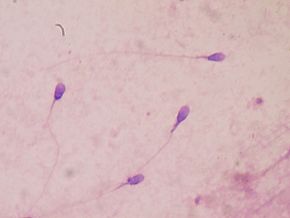 Air pollution is linked to so many negative health effects, now another one - poorer quality sperm. In this study 6475 males (ages ranged from 15–49 years) had their sperm analyzed as part of a standard medical examination program in Taiwan. They were also able to get air pollution measurements for each person's address for that time period. They found that both short-term and long-term exposure to higher levels of fine particulate matter (PM2.5) pollution were linked to lower numbers of sperm being normal in size and shape (sperm morphology), but with a higher concentration of sperm. Perhaps a compensatory phenomenon?
Air pollution is linked to so many negative health effects, now another one - poorer quality sperm. In this study 6475 males (ages ranged from 15–49 years) had their sperm analyzed as part of a standard medical examination program in Taiwan. They were also able to get air pollution measurements for each person's address for that time period. They found that both short-term and long-term exposure to higher levels of fine particulate matter (PM2.5) pollution were linked to lower numbers of sperm being normal in size and shape (sperm morphology), but with a higher concentration of sperm. Perhaps a compensatory phenomenon?
The researchers pointed out that other studies have also found effects from air pollution on sperm. Since this study only analyzed a person's sperm one time, the findings are correlational (they observed an association, but couldn't definitely say it caused the effect). [Some other posts on sperm quality: here, here, here.] From Medical Xpress:
Air pollution linked to poorer quality sperm
Air pollution, particularly levels of fine particulate matter (PM2.5), is associated with poorer quality sperm, suggests research published online in Occupational & Environmental Medicine. Although the size of the effect is relatively small in clinical terms, given how widespread air pollution is, this might spell infertility for a "significant number of couples," say the researchers.
Environmental exposure to chemicals is thought to be a potential factor in worsening sperm quality, but the jury is still out on whether air pollution might also have a role. To explore this possibility further, the international team of researchers looked at the impact on health of short and long term exposure to fine particulate matter (PM2.5) among nearly 6500 15 to 49 year old men in Taiwan.
The men were all taking part in a standard medical examination programme between 2001 and 2014, during which their sperm quality was assessed (total numbers, shape/size, movement) as set out by World Health Organization guidelines. PM2.5 levels were estimated for each man's home address for a period of three months, as that is how long it takes for sperm to be generated, and for an average of 2 years, using a new mathematical approach combined with NASA satellite data.
A strong association between PM2.5 exposure and abnormal sperm shape was found. Every 5 ug/m3 increase in fine particulate matter across the 2 year average was associated with a significant drop in normal sperm shape/size of 1.29 per cent. And it was associated with a 26 per cent heightened risk of being in the bottom 10 per cent of normal sperm size and shape, after taking account of potentially influential factors, such as smoking and drinking, age or overweight. However, it was also associated with a significant increase in sperm numbers, possibly as a compensatory mechanism to combat the detrimental effects on shape and size, suggest the researchers. Similar findings were evident after three months of exposure to PM2.5. [Original study.]
